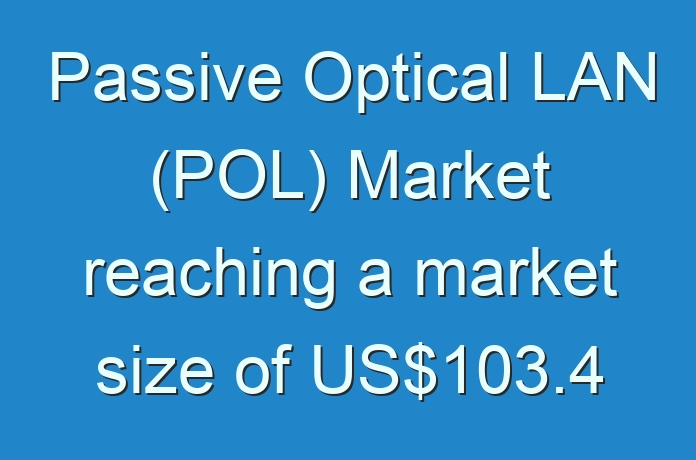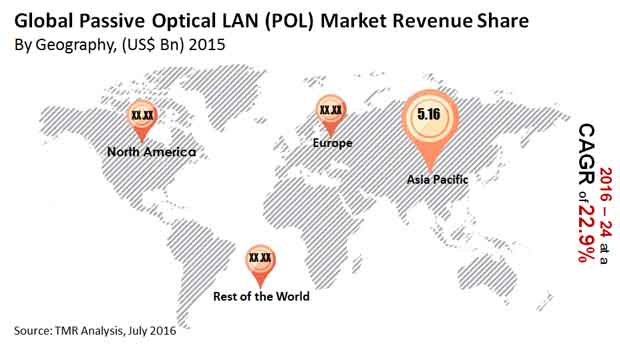
The market for passive optical LAN (POL) is poised for substantial growth in the coming years, registering a double-digit CAGR through the forecast period. Escalating bandwidth requirements, coupled with the energy efficient nature of passive optical components, is driving the POL market. The growth of networking technologies in the Asia Pacific and RoW markets, increasing fiber deployments, and rising investments in technological advancements and research infrastructure across both the regions are also propelling the passive optical LAN market.
The global passive optical LAN market is expected to expand at an impressive CAGR of 22.9% during the forecast period from 2016 to 2024, reaching a market size of US$103.4 bn by 2024. The market stood at US$14.1 bn in 2015.

Increased Usage of Optical Amplifiers in Ultra-high Capacity Networks
The key components of a passive optical LAN include cables, power splitters, filters, wavelength division multiplexers/de-multiplexers, couplers, encoders, connectors, patch cords and pigtails, amplifiers, attenuators, transceivers, circulators, network terminals, and line terminals. The global passive optical LAN market was led by the wavelength division multiplexers/de-multiplexers segment in 2015, followed by optical amplifiers. The latter enjoys a significant share in the POL market owing to their increased use in ultra-high capacity networks. Fixed and variable optical attenuators and amplifiers are likely to grow at an above average CAGR over the course of the forecast period following the increasing demand for higher bandwidths and rapid growth in fiber optic technologies.
Asia Pacific to Retain Lead in POL Market throughout Forecast Period
In 2015, Asia Pacific led the market for POL, accounting for a share of more than 36%. The growing demand for passive optical networks in the region, especially in China, is one of the primary forces driving this passive optical LAN market. A surge in data traffic and the use of electronic gadgets by a large volume of customers further drives the APAC market. Governments of major countries across the region are planning to invest in the deployment of fiber optic networks to improve the network infrastructure in their respective countries. This is anticipated to boost the Asia Pacific market for passive optical LAN during the forecast period.
North America is also a key contributor to the growth of the POL market globally. Technological advancements and an increasing demand for more advanced security are some factors that can be expected to boost the growth of passive optical LAN in North America. Furthermore, the rising demand for energy conservation and simplified network operations is anticipated to bolster the growth of the POL market in this region. The passive optical LAN market in North America is expected to grow at a remarkable CAGR of 20.0% over the forecast period.
Ask for brochure:
https://www.transparencymarketresearch.com/sample/sample.php?flag=B&rep_id=2945
The growing demand for energy-efficient solutions and increased investments in network solutions and research infrastructure are propelling the passive optical LAN market in RoW countries such as Brazil and South Africa. In addition, major investments have been lined up in wireless cell tower base stations as the volume of network traffic grows exponentially in the RoW.
Some of the leading players in the POL market are Alcatel Lucent SA (France), Ericsson Inc. (Sweden), Huawei Technologies Co. Ltd. (China), ADTRAN, Inc. (U.S.), TE Connectivity Ltd. (Switzerland), ZTE Corporation (China), and Verizon Communications Inc. (U.S.)
Passive Optical LAN (POL) Market – Snapshot
The increasing demand for passive optical networks all across the world is the primary driver for the growth of the global passive optical LAN market. The growing need for higher bandwidth is further propelling the demand for passive optical networks worldwide. Manufacturers of this market are also seizing this opportunity to turn this in their favor and are thereby indulging in research and development tactics so as to generate significant revenues. A vast majority of players are investing heavily on the introduction and implementation of innovative technologies to generate better revenues in the coming years.
Geographically, the market is dominated by Asia Pacific and is expected to continue doing the same in the coming years on account of the rising demand for passive optical network in the emerging nations such as China. The increasing demand for more bandwidth and the fact that passive optical LAN systems are energy efficient and long lasting, have further propelled its demand in the developing nations of Asia Pacific such as India, and others. The development of systems administration advances in the Asia Pacific and markets in the other parts of the world, expanding fiber organizations, and rising interests in innovative headways and exploration framework across both the locales are additionally pushing the passive optical LAN market.
On the other side, North America stands in close competition to Asia Pacific and generate notable revenues on account of the rising demand for advanced security and for energy preservation. There is also an increased demand for simplified network operations will also add fuel to the growth of the passive optical LAN market in the coming years.
POL arrangements are environment-friendly than regular copper-based Ethernet neighborhood. This is relied upon to additional support the passive optical LAN market over the figure time frame. The rising adoption of energy-efficient products is likely to create lucrative growth opportunities for the market in the coming years.
Read Our Trending Press Release Below:





